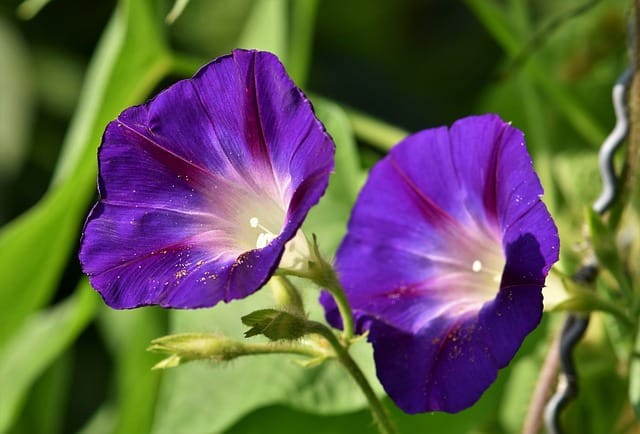How to grow Morning Glories
Morning Glories (Ipomoea spp

In this article:
- Introduction
- Choosing the Right Morning Glory Variety
- Prep Work: Soil Preparation and Planting Location
- Planting Morning Glory Seeds
- Caring for Young Morning Glory Plants
- Proper Watering Techniques
- Feeding and Fertilizing Morning Glories
- Supporting Morning Glory Vines
- Pruning and Training Morning Glory Plants
- Dealing with Common Pests and Diseases
- Harvesting Morning Glory Seeds
- Overwintering and Propagating Morning Glories
- Tips for Successful Morning Glory Cultivation
- Troubleshooting Common Growth Issues
- Conclusion
Introduction
Morning Glories (Ipomoea spp.) are beautiful flowering plants that add color and charm to any garden or landscape. Known for their vibrant, trumpet-shaped flowers that bloom in the morning, these annual climbers are relatively easy to grow and require minimal care. This article will guide you through the process of successfully growing Morning Glory plants from seeds to harvest.
Choosing the Right Morning Glory Variety
There are numerous Morning Glory varieties available, each with its own unique colors and characteristics. Consider factors such as bloom size, color, and growing habit when selecting the right variety for your garden. Some popular choices include Grandpa Ott's, Heavenly Blue, and Scarlet O'Hara.
Prep Work: Soil Preparation and Planting Location
Morning Glories prefer well-draining soil with a slightly acidic to neutral pH. Prepare the planting site by removing any weeds, rocks, or debris and mixing in organic matter like compost to improve soil fertility and drainage.
Planting Morning Glory Seeds
It is best to start Morning Glory plants from seeds indoors about four to six weeks before the last frost date in your area. Sow the seeds in small pots or seed trays filled with seed-starting mix, ensuring they are barely covered with soil. Keep the soil consistently moist and provide sufficient light to promote germination. Once the danger of frost has passed, transplant the seedlings into their permanent location in the garden or containers.
Caring for Young Morning Glory Plants
After transplanting, provide young Morning Glory plants with adequate sunlight (at least six hours per day) and protect them from strong winds. Water regularly, keeping the soil evenly moist to encourage healthy growth.
Proper Watering Techniques
Morning Glories prefer moderate watering and can handle short dry spells. Avoid overwatering, as it can lead to root rot and other fungal diseases. Water the plants at the base to prevent wet foliage, which can invite fungal infections.
Feeding and Fertilizing Morning Glories
Morning Glories are relatively low-maintenance and do not require excessive fertilization. However, incorporating a slow-release granular fertilizer into the soil during planting and supplementing with a balanced liquid fertilizer every four to six weeks can promote vigorous growth and abundant blooms.
Supporting Morning Glory Vines
As climbing plants, Morning Glories need support to grow vertically. Install trellises, arbors, or fences for the vines to cling to. Make sure the structure is sturdy enough to withstand the weight of the plants when they reach their mature size.
Pruning and Training Morning Glory Plants
To maintain a tidy and compact appearance, prune Morning Glory plants by removing any dead, damaged, or diseased foliage. Training the vines to grow in the desired direction will also help prevent overcrowding and entanglement.
Dealing with Common Pests and Diseases
Morning Glories are generally resistant to pests and diseases. However, occasional issues like aphids, spider mites, and powdery mildew may arise. Regularly inspect the plants, and if any problems are detected, treat them with appropriate organic pest control methods or mildews. Ensure good air circulation and avoid overcrowding plants to minimize the risk of diseases.
Harvesting Morning Glory Seeds
Allow some Morning Glory flowers to wither and dry on the vine to harvest their seeds. Once the seed pods turn brown and feel dry, gently break them open to collect the mature seeds. Store the seeds in a cool, dry place until the next planting season.
Overwintering and Propagating Morning Glories
Morning Glories are annuals and will die at the end of the growing season. However, you can collect seeds for propagation in the following year. To overwinter Morning Glory plants, bring potted specimens indoors before the first frost. Reduce watering and place them in a cool, dark area such as a basement or garage. Resume regular care in the spring to encourage new growth.
Tips for Successful Morning Glory Cultivation
- Choose a sunny location with well-draining soil and good air circulation.
- Provide adequate support for climbing vines.
- Regularly deadhead spent flowers to encourage continuous blooming.
- Mulch around the plants to suppress weeds and retain soil moisture.
Troubleshooting Common Growth Issues
- If Morning Glory plants are not blooming, they may require more sunlight. Ensure they receive at least six hours of direct sunlight daily.
- If the vines become excessively leafy but produce few flowers, reduce nitrogen fertilization, as high nitrogen levels promote foliage growth at the expense of blooms.
Conclusion
Growing Morning Glory plants can be a rewarding endeavor. With proper care and attention to their needs, you can enjoy a vibrant display of colorful blooms that brighten your garden and attract pollinators. Remember to choose the right variety, provide adequate support, and follow the recommended techniques to achieve successful Morning Glory cultivation.
